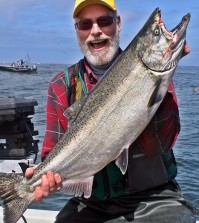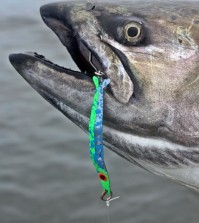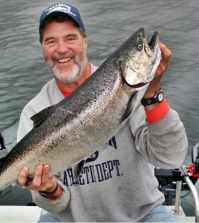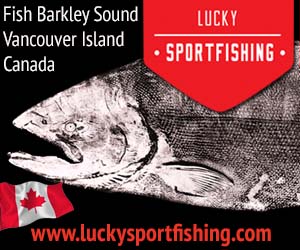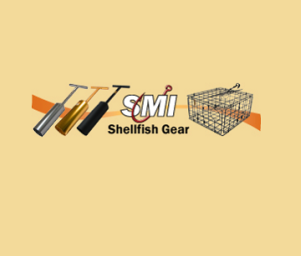Silvers on the Surface

Terry and Adam Rudnick show off a late-season Coho
that grabbed a plug-cut herring fished in the prop-wash
about two rod-lengths behind the boat. (Terry Rudnick photo)
Back in the late-eighties I got to know a guy named Joe Wallman, and for a few years we spent a fair amount of time together on the water. I enjoyed fishing with Joe not only because he was a good guy and a good fisherman, but also because I was a full-time freelance writer at that time and his often-unorthodox angling methods made for some very interesting and entertaining newspaper and magazine articles. Case in point: the morning he taught me his secret, sure-fire technique for catching shallow-water Coho in Puget Sound. Thanks to me, his methods are no longer a secret, but they’re certainly effective, and I’ve used some of them now and again to my own advantage.
That particular day back in 1990-something, Joe took me to a shallow flat near the south end of Anderson Island where, he said, resident Coho often congregated to feed among the many boulders that were strewn around the bottom. He had told me the fish would be fairly small—two to maybe three pounds—and to bring light tackle, but I quickly realized that my idea of light salmon tackle was different from Joe’s. I was armed with a 7-foot, medium-action spinning rod and a reel spooled with 8- or 10-pound monofilament, while his outfit consisted of a 9-foot rod with oversize guides built on a fly-rod blank and a reel sporting 4-pound mono. “I can cast a mile with this rig,” he announced, and I had no reason to doubt him.
My doubt did begin to grow, however, when he pulled a couple of small boxes from his tackle box, each containing a shiny new Rapala minnow, then pulled out a needle-nose pliers and broke the little plastic bill off the nose of both lures. Now I was becoming pretty sure that ol’ Joe was going nuts, until he explained that he didn’t want the lures diving even a few inches beneath the surface, and the only way he could ensure that was to remove the diving bills.
“Just cast as far as you can toward the beach, reel a few feet, stop, give it a little twitch or two, reel again and bring it all the way back to the boat like that, Joe advised, and I followed his instructions. The advantages of his longer rod and lighter line quickly became obvious, as his first cast sailed about twice as far as mine, and his “modified” Rapala had twitched and darted only a few yards toward the boat when it disappeared in an eruption of spray and foam. A couple of minutes later, a shiny, 3-pound Coho slid into the fish box under one of the seats in Joe’s boat. He caught a second, slightly smaller Coho and lost another before I finally broke the ice and made my first and only contribution of the morning.
Since that day on the south-sound I’ve used Joe Wallman’s surface-plug technique several times to put shallow-water and surface-feeding Coho in the boat, and I’m happy to report that tackle technology has developed to the point that I have found a number of baitfish-imitating surface lures for the job, so I haven’t had to mutilate any Rapalas in the process. And I should add that shallow-running plugs can be every bit as effective as surface-hopping lures. Many of the models used for bass and other warm water species are designed to run a foot or two under the surface, and I’ve had some great Coho days using them on the salt.
Coho are the one Pacific salmon species that’s most likely to be found on or near the water’s surface, and when you can catch them there it adds a whole new and exciting dimension to a day’s fishing. When they smack a bait or lure on the surface they’re very likely to come clear out of the water on the strike, and it’s also likely that there will be other twisting, turning, summersaulting Coho jumps after that first one.
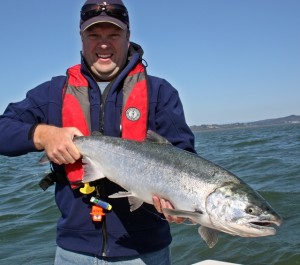
A Blue Fox spinner trolled near the surface fooled this husky
Willapa Bay Coho for Harley Graves. (Terry Rudnick photo)
While Joe Wallman was using his ruptured-Rapala trick at least 30 years ago, there’s another technique for catching silvers on the surface that has been around a lot longer and much more well-known. It’s called buck-tailing, and was a popular method of catching big, late-run Coho around Neah Bay and Vancouver Island as far back as the sixties, perhaps earlier. For the uninformed, buck-tailing is nothing more than trolling a large bucktail or streamer fly on or near the surface, usually with a fairly heavy fly rod and single-action reel. The flies are typically made of polar bear or deer hair (or synthetic variations) and trolled on a monofilament line. It’s sort of like fishing dry flies for huge trout, only you don’t have to know how to cast a fly.
Spinners are another good option for catching surface and near-surface Coho. From about the middle of August until the saltwater Coho fishery grinds to a halt sometime in October, a friend of mine keeps at least one spinner in the water whenever he’s trolling, and his spinner rod sees a heck of a lot of action during those weeks of late-summer and early fall. He typically fishes his spinners on a long rod (9 feet or longer) and that rod is nearly vertical in the holder, to help keep the spinner high in the water column. A size 4 Blue Fox in chartreuse or blue is one of his favorites for late-season Coho, but he’s also done well with Yakima Bait’s proven salmon spinner, the Flash Glo.
And don’t forget that casting spinners for Coho can be every bit as effective as trolling them, especially when you see fish jumping and rolling on the surface. Keep in mind that they can be a little skittish when they’re doing that, so long casts may be required to reach them without scaring them off.

If you think bass tackle won’t catch Pacific salmon;
take a closer look at the shallow-diving plug hanging
from the jaw of this Westport Coho. (Terry Rudnick photo)
Long casts may also be required when fishing another fall favorite Coho-getter, the Buzz Bomb. These long, thin jigs are well-suited to fishing the upper few feet of the water column, where Coho are most frequently found. Fished in a way that I call horizontal jigging, the smaller, lighter Buzz Bomb models can easily be fished within a couple feet of the surface if you allow it to sink for only a second or two on the down-stroke of the jigging motion and then reel quickly on the up-stroke. A longer pause on the down-stroke and slower retrieve, of course, will allow the lure to sink farther and fish deeper.
The Buzz Bomb, by the way, isn’t the only metal jig that can be fished effectively for near-surface silvers. Such jigs as the Cripple Herring, Point Wilson Dart, Sonic Baitfish and others in weights of one ounce or lighter can be fished with a lift-and-drop retrieve near the surface much like the Buzz Bomb, and with equally impressive results.

A morning’s catch of shallow-water Coho will bring a smile
to the face of any serious salmon fisherman. (Terry Rudnick photo)
Okay, now for one that you probably haven’t heard of. A buddy of mine who lives and fishes a lot down here at the south end of Puget Sound discovered a few years back that a floating plastic worm—the kind used for bass fishing—had some resemblance to an injured candlefish, because an injured or disoriented candlefish actually rises to the surface rather than sinking into the depths, and Coho tend to fall for ruse quite readily. His favorite worm is one called the Robo Worm, and he usually rigs it with a small hook (he likes a size 4 Owner SSW) at the top end and a second hook that hangs free toward the back end of the worm. He uses a light fluorocarbon leader and 8 or 10-pound mono main line. He uses a black barrel swivel to connect line and leader, and there’s no sinker anywhere in the set-up. He sometimes casts to jumping and rolling fish, but more often he trolls the rig at a fairly fast clip, often lifting and dropping the rod to impart a sinking and rising action to the worm. Because he’s using small, sharp hooks, the fish usually stick themselves on the strike, so there’s no need for a hook-set, he says.
All the fishing techniques described so far will catch Coho feeding on or near the surface, but if I had to pick a favorite, it might be trolling a whole or plug-cut herring in the prop-wash right behind the boat. I use little or no weight when fishing this way, so that the bait is skipping in and out of the water as I troll at a fairly good clip (3 to sometimes 4 knots). There seems to be something about the turbulence, foam and bubbles generated by the spinning prop and moving boat that draws hungry Coho in for a closer look, especially during the first hour or so of daylight and again at dusk, and there’s nothing like a Coho strike on 10 or 15 feet of line to put a bend in a salmon rod and make the hair stand up on the back of your neck.




